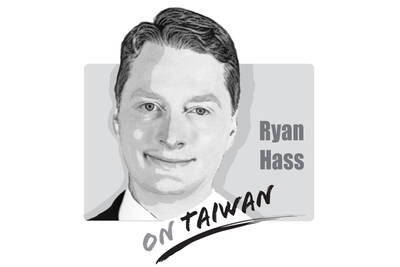President Ma Ying-jeou (馬英九) has performed poorly during his time in office; his campaign slogan “total government, total responsibility” is nothing but empty words. Ma is a true politician. He excels in taking credit for things that go right and passing the buck when they go wrong.
Ma exploits former president Chen Shui-bian (陳水扁) for his own political benefit, using him to foment ethnic tensions through Chen’s continued imprisonment. As a result, non-violent democratic reforms have been tainted by confrontation between the ruling Chinese Nationalist Party (KMT) and opposition camps. Although Ma named the plaza at Ketagalan Boulevard in front of the Presidential Office Building the “democratic plaza against corruption,” it should have been called the “corruption plaza against democracy.” What an embarrassment.
Ma has placed his hopes in China, his great benefactor, depending on Beijing, while putting Taiwan’s sovereignty at risk. Meanwhile, the People’s Republic of China (PRC) continues to bully the Republic of China (ROC). On Monday, China’s Global Times even mocked Ma as a “local government head” after he expressed support for the Occupy Central pro-democracy movement in Hong Kong.
With the nine-in-one elections approaching, now is a good time for voters to scrutinize Ma’s political record. Some say that the nation cannot make progress until the KMT collapses.
The KMT nominated former Kaohsiung County commissioner Yang Chiu-hsing (楊秋興), who left the Democratic Progressive Party (DPP), and National University of Tainan president Huang Hsiu-shuang (黃秀霜) for the Kaohsiung and Tainan mayoral elections respectively.
However, their support ratings are significantly lower than those of the DPP’s Kaohsiung Mayor Chen Chu (陳菊) and Tainan Mayor William Lai (賴清德), who are both running for re-election.
In Greater Taichung, DPP mayoral candidate Lin Chia-lung’s (林佳龍) support ratings are also much higher than those of the KMT’s Greater Taichung Mayor Jason Hu (胡志強), who is running for re-election.
As for Taipei City, independent mayoral candidate Ko Wen-je (柯文哲) is an “atypical” candidate, having formed a “grand opposition coalition,” and has a high degree of support among younger voters and women. He has surpassed the blue and green camps on the political map, with higher support ratings than the KMT’s mayoral candidate, Sean Lien (連戰), who has been abandoned by some KMT members.
However, some KMT politicians have attempted to create friction between the blue and green camps to help Lien by stirring up the party’s supporters. Even the KMT’s Legislative Speaker Wang Jin-pyng (王金平), after being repeatedly insulted by Ma, recently said that Lien is likely to win the Taipei mayoral election. Is he serious?
In order to save the KMT, the nation should let the party fail, so it can wake up and understand the true meaning of democracy. Voters should terminate KMT rule so a new nation can be born. Then, as the ROC transforms into a new nation named Taiwan, it can end the PRC’s ambition to annex the ROC.
If the KMT suffers a major defeat in the elections, the party would have to review itself before the 2016 presidential and legislative elections. This might change the evil KMT regime, and the fake nation named the ROC.
The recent food safety scandals reflect the poor health of the nation’s politics. To address the problem from the roots, the KMT should be removed from power. The public must distinguish between right and wrong, and in doing so, it can make progress toward a promising new nation.
Lee Min-yung is a poet.
Translated by Eddy Chang

There has been much catastrophizing in Taiwan recently about America becoming more unreliable as a bulwark against Chinese pressure. Some of this has been sparked by debates in Washington about whether the United States should defend Taiwan in event of conflict. There also were understandable anxieties about whether President Trump would sacrifice Taiwan’s interests for a trade deal when he sat down with President Xi (習近平) in late October. On top of that, Taiwan’s opposition political leaders have sought to score political points by attacking the Lai (賴清德) administration for mishandling relations with the United States. Part of this budding anxiety
The diplomatic dispute between China and Japan over Japanese Prime Minister Sanae Takaichi’s comments in the Japanese Diet continues to escalate. In a letter to UN Secretary-General Antonio Guterres, China’s UN Ambassador Fu Cong (傅聰) wrote that, “if Japan dares to attempt an armed intervention in the cross-Strait situation, it would be an act of aggression.” There was no indication that Fu was aware of the irony implicit in the complaint. Until this point, Beijing had limited its remonstrations to diplomatic summonses and weaponization of economic levers, such as banning Japanese seafood imports, discouraging Chinese from traveling to Japan or issuing
Tokyo-Beijing relations have been rapidly deteriorating over the past two weeks as China tries to punish Japan over Japanese Prime Minister Sanae Takaichi’s remarks about Taiwan earlier this month, and the off-ramp to this conflict is yet to be seen. Takaichi saying that a “Taiwan contingency” could cause a “situation threatening Japan’s survival” — which would allow Japan to act in self-defense — has drawn Beijing’s ire and sparked retaliatory measures. Her remark did not gain public attention until Chinese Consul General in Osaka Xue Jian (薛劍) made an apparent threat to behead her. The two sides lodged protests against each
On Nov. 8, newly elected Chinese Nationalist Party (KMT) Chairwoman Cheng Li-wun (鄭麗文) and Vice Chairman Chi Lin-len (季麟連) attended a memorial for White Terror era victims, during which convicted Chinese Communist Party (CCP) spies such as Wu Shi (吳石) were also honored. Cheng’s participation in the ceremony, which she said was part of her efforts to promote cross-strait reconciliation, has trapped herself and her party into the KMT’s dark past, and risks putting the party back on its old disastrous road. Wu, a lieutenant general who was the Ministry of National Defense’s deputy chief of the general staff, was recruited